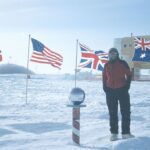Australian universities have achieved a 70 per cent growth in Indigenous enrolments in the past decade1, yet attrition rates remain high. Aaron Matthews is a Curtin researcher with the Centre for Aboriginal Studies (CAS) who is examining ways to improve the tertiary experience for Indigenous students to ensure they have the best opportunities to succeed at university.
As a former Curtin student, Matthews has unique insight into the Indigenous uni student experience. An Aboriginal man from the Kija (East Kimberley) and Gurindji (Northern Territory) language groups, he graduated with a Bachelor of Applied Science in Indigenous Community Management and Development (ICMD) with Honours in 2009.
Matthews now lectures in the ICMD program and is undertaking a Master of Education, investigating how tertiary enabling programs can be enhanced for future generations of Indigenous students.
“I’ve kind of gone full circle. I’ve had opportunities at CAS as both student and teacher, and that’s been really interesting because it’s enabled me to experience education from both sides,” says Matthews.
“I’ve now been able to step back from teaching so I can focus on my research and start creating new ways for Indigenous higher education.”
“We all share a common goal of wanting to access education and use it to benefit our communities – that’s why I’m here doing what I do.”
Matthews says there have significant improvements in education delivery and access for Indigenous Australians, but there are still barriers that make it difficult for students to prioritise and fully engage with their studies.
“You might have a student who has aspirations to go to university, but they’re weighed down by financial, social, cultural or family responsibilities, or are dealing with culture shock from moving away from home to the city,” says Matthews.
“And they’re probably dealing with a bit of guilt as well, because studying is quite an individual thing – you go off to pursue your own interests and it takes up a lot of your time and it can be difficult for families to understand.”
CAS has implemented a number of initiatives to help students feel comfortable at Curtin and get the most from their studies. In addition to its bridging and enabling programs, some of the centre’s courses are delivered in block units, enabling students to learn course content for two weeks at a time throughout the year. This helps them to balance study with their other commitments and is especially beneficial for students who live in regional or remote communities.
There is a mentor program for first-year students, as well as a Tutorial Assistance Scheme, which provides private tutoring to eligible students studying an undergraduate degree.
CAS also holds a number of events throughout the year to ensure students and staff have the chance to connect and share experiences.
“There are morning teas and community forums, as well as presentations from important members in the community,” says Matthews.
“The CAS building itself is quite beautiful and gives people a sense of connection. It’s also the people within it as well – the teachers are always willing to work with students.”
Matthews says CAS is a strong example of a higher tertiary centre that is advancing Indigenous education, but he would like to see more collaboration between institutions, as it can generate a greater exchange of ideas and promote best practice.
“At the end of the day, we all want to reach the same goal. We need to communicate with and learn from one another to try and increase the number of Indigenous students who are ready to engage with tertiary education.”
Matthews hopes that his master’s research will help to innovate the delivery of Indigenous courses across all Australian universities. For example, he is looking at how technology can be better integrated into teaching and learning to align with how today’s generation of students learn and engage. He also envisions a future where Aboriginal and Torres Strait Islander knowledge and perspectives are embedded in all university courses, rather than confined to individual programs.
In the meantime, the CAS alumnus encourages Indigenous Australians to “give uni a go.”
“Until you actually put your feet in and see what it’s about, you won’t know if uni is for you or not. There’s so much about it that you won’t experience until you’re here, so it’s just one of those things where you just have to give it a go!”
1 Universities Australia. (2017). Indigenous Strategy 2017-2020. Retrieved from universitiesaustralia.edu.au, 10 July 2018.



